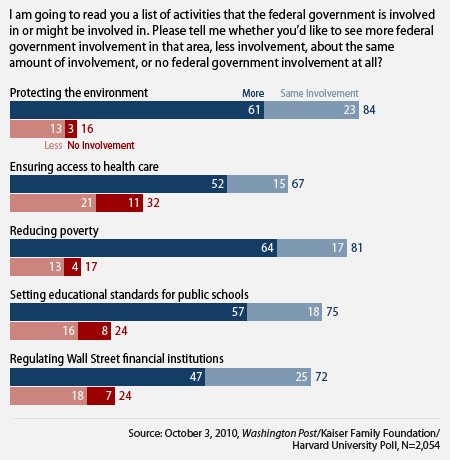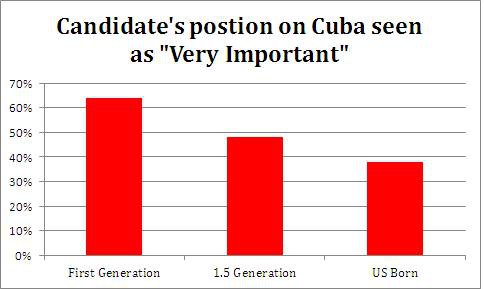If you listened to conservatives and some media accounts you’d think there was an enormous public groundswell to reduce the size of government as rapidly as possible. But that does not appear to be the case. Widespread dissatisfaction with government performance has not translated into strong support for cutting government. Consider these results from a just-released survey on Americans’ attitudes toward government conducted by The Washington Post, the Kaiser Family Foundation, and Harvard University.
The public was asked if they supported more, less, about the same, or no federal government involvement in dealing with a variety of issues. On five domestic policy issues majorities ranging from 67 to 84 percent wanted to see either the same or more federal government involvement in the issue. (In fact, on four of these issues outright majorities actually wanted to see more federal involvement.) Those wanting to see less or no involvement ranged from only 32 down to 16 percent.

Doesn’t sound like cutting government mania has taken hold in these areas. Then consider this result from a general question about whether you’d rather have the federal government provide more services even if it cost more in taxes or have the federal government cost less in taxes but provide fewer services.
A slight plurality (49 percent) preferred the first government-expanding option over the second government-cutting option (47 percent). Even more interestingly, these sentiments are notably less hostile to government’s role than has been the case at a number of points in the past. In 1994 only 28 percent selected the government-expanding option, while 57 percent preferred the government-cutting option.

Finally, what does the public say they want their representative in Congress to do—fight for more spending to create jobs in their district or fight to cut government spending even if that means fewer jobs in the district?
It’s a crucial time to fight ignorance – help Truthout get the word out by donating here.
It turns out that, by 57-39, they want their representative to fight for more spending to create jobs. Again, there is no evidence here of an overriding commitment to cut government. And again we see a less hostile attitude toward government’s role than was seen back in 1994 when, by 53-42, the public came down on the cutting spending side of the choice.

So does the public want to see government performance improved? Yes, and in a big way. But don’t believe the conservative hype about a public thirsty to cut government. It’s just not happening.
Ruy Teixeira is a Senior Fellow at the Center for American Progress. To learn more about his public opinion analysis go to the Media and Progressive Values page and the Progressive Studies program page of our website.
We’re not backing down in the face of Trump’s threats.
As Donald Trump is inaugurated a second time, independent media organizations are faced with urgent mandates: Tell the truth more loudly than ever before. Do that work even as our standard modes of distribution (such as social media platforms) are being manipulated and curtailed by forces of fascist repression and ruthless capitalism. Do that work even as journalism and journalists face targeted attacks, including from the government itself. And do that work in community, never forgetting that we’re not shouting into a faceless void – we’re reaching out to real people amid a life-threatening political climate.
Our task is formidable, and it requires us to ground ourselves in our principles, remind ourselves of our utility, dig in and commit.
As a dizzying number of corporate news organizations – either through need or greed – rush to implement new ways to further monetize their content, and others acquiesce to Trump’s wishes, now is a time for movement media-makers to double down on community-first models.
At Truthout, we are reaffirming our commitments on this front: We won’t run ads or have a paywall because we believe that everyone should have access to information, and that access should exist without barriers and free of distractions from craven corporate interests. We recognize the implications for democracy when information-seekers click a link only to find the article trapped behind a paywall or buried on a page with dozens of invasive ads. The laws of capitalism dictate an unending increase in monetization, and much of the media simply follows those laws. Truthout and many of our peers are dedicating ourselves to following other paths – a commitment which feels vital in a moment when corporations are evermore overtly embedded in government.
Over 80 percent of Truthout‘s funding comes from small individual donations from our community of readers, and the remaining 20 percent comes from a handful of social justice-oriented foundations. Over a third of our total budget is supported by recurring monthly donors, many of whom give because they want to help us keep Truthout barrier-free for everyone.
You can help by giving today. Whether you can make a small monthly donation or a larger gift, Truthout only works with your support.